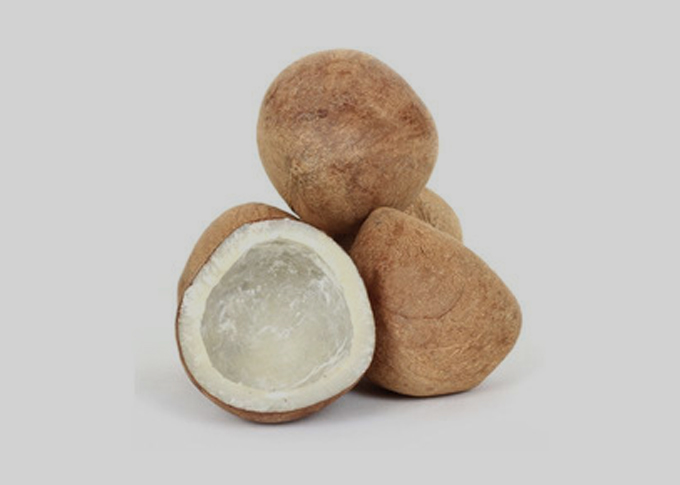Coconut oil obtained from coconut milk is called virgin coconut oil. Traditional and modern methods are available for the manufacture of virgin coconut oil. In the traditional method, milk extracted from grated coconut kernel is boiled to get oil. Of late, the traditional method has been partially mechanized using a bridge press and mechanical grater. The modern method of extracting oil from fresh coconut kernel is known as wet processing.
The Virgin coconut oil is considered superior for use as edible oil, hair oil and baby oil because of its pleasing aroma and purity. It is applied on the body of babies to protect from skin diseases. Because of its low FFA content, this oil has a longer shelf life.
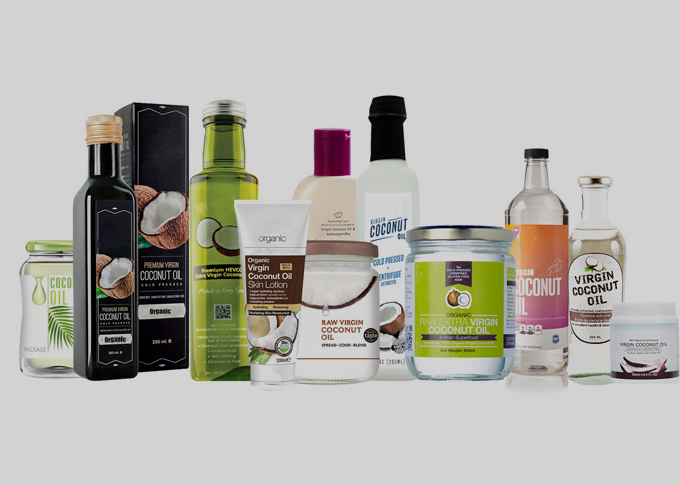
|
Composition of VCO as per APCC |
||
|
Sl. No |
Parameters |
|
|
1 |
Moisture (%) |
Max 0.1 |
|
2 |
Matters Volatile at 1200 C (%) |
Max 0.2 |
|
3 |
Free Fatty Acid (%) |
Max 0.2 |
|
4 |
Peroxide Value meq/kg |
Max 3 |
|
5 |
Relative density |
0.915 – 0.920 |
|
6 |
Refractive index at 400 C |
1.4480 –1.4492 |
|
7 |
Insoluble impurities per cent by mass |
Max 0.05 |
|
8 |
Saponification Value |
250 – 260 min |
|
9 |
Iodine Value |
4.1 -11 |
|
10 |
Unsaponifiable matter % by mass |
max 0.2 - 0.5 |
|
11 |
Specific gravity at 30 deg./30 deg. C |
0.915 – 0.920 |
|
12 |
Polenske Value |
min 13 |
|
13 |
Total Plate Count |
< 0.5 |
|
14 |
Color |
Water clean |
|
15 |
Odor and Taste |
Natural fresh coconut scent, |
Dehydrated coconut meat in the grated and shredded form is desiccated coconut (DC). A large number of units in India are manufacturing DC which is mainly absorbed by the confectionery and other food industries. DC is also used as a substitute to grated coconut in various household preparations. DC is available in different grades based on the fineness of the material.
|
Composition of Desiccated Coconut |
||
|
Sl. No |
Item |
Quantity |
|
1 |
Moisture |
1.3-2.5% |
|
2 |
Protein |
6.0-6.6% |
|
3 |
Oil |
68-72% |
|
4 |
Carbohydrate |
18-20% |
|
5 |
Crude fibre |
4-6% |
|
Source* - Tropical Foods, Chemistry and Nutrition,Volume 2, George E Inglett |
||
Coconut Milk is the oil-protein-water emulsion obtained by squeezing fresh grated coconut kernel. The undiluted and diluted forms are called coconut milk and the concentrated form is coconut cream. Coconut milk is obtained by extraction of fresh coconut wet gratings with or without water. This is an instant product, which can either be used directly/diluted with water to make various preparations such as fi sh & meat dishes, curries, sweets, deserts, puddings, cocktails, cakes, cookies, coconut jam, ice creams etc. It can also be used in the manufacture of bakery products and for coconut milk fl avouring food stuffs. Preserved forms of coconut milk such as canned cream or milk and dehydrated whole milk are now available in many coconut growing countries. Commercial production of these products has been promoted in the Philippines, Thailand, Indonesia, Western Samoa, Sri Lanka and Malaysia and to some extent in India. Indonesia is the leading exporter of coconut milk followed by Sri Lanka, Thailand and Philippines.
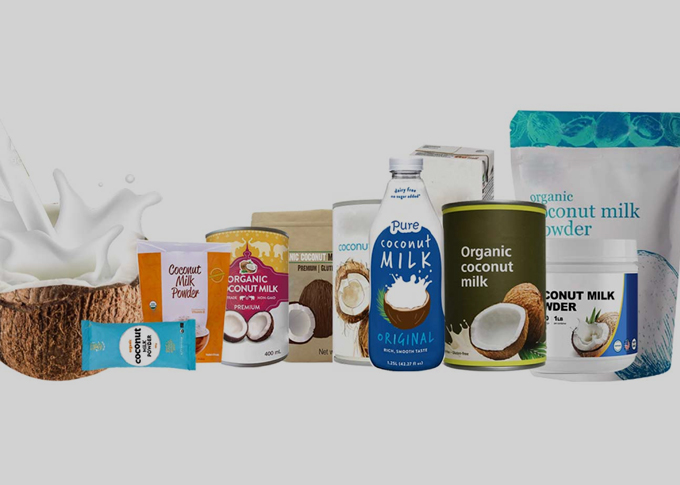
plant protein and is an invaluable material for the preparation of milk substitutes. Coconut skimmed milk is a solution of the soluble components of coconut after the cream is separated in a cream separator. Skimmed milk is a good source of quality protein suitable for the preparation of many useful food products or as supplemental protein source, especially in regions deficient in animal proteins. Freshly prepared coconut milk from pared kernel is filtered through a 120 mesh vibrating screen and the pH of the filtered milk is raised from 6.3 to 7.0 with the additions of sodium hydroxide. The milk is then pasteurized at about 60oC for one hour and subsequently centrifuged in a cream separator to yield the aqueous phase or the protein rich skimmed milk.
Spray drying is the best method for the preservation of coconut milk. Spray dried coconut milk powder is reconstituted into coconut milk by adding water which can be used to make various food preparations. The product offers additional advantages such as less storage space, bulk packaging at reduced cost and longer shelf life. Technology for the manufacture of spray dried coconut milk powder is available with the Coconut Development Board.
Processed and packed coconut cream is a ready-touse product which can either be used directly or diluted with water in various edible preparations. Coconut cream when partially defatted is called coconut milk. Coconut cream/ milk is used as an ingredient in household recipes and as a component of processed foods. Coconut milk is also used as coconut cream, a mixer in alcoholic drinks. Coconut milk/cream is available in pouches, bottles and tetra packs. Technology for the manufacture of coconut cream is available with Coconut Development Board.
|
Product Specification |
|
|
Appearance |
White smooth creamy consistency |
|
Flavour |
Coconut |
|
Fat |
23% |
|
Protein |
4% |
|
Sugars |
5% |
|
Others |
1% |
|
Water |
67% |
Coconut chips are a ready-to-eat snack food. It is prepared in salted and sweetened forms. The Central Plantation Crops Research Institute, Kasaragod has standardized the process for preparation of chips. Coconuts of 9-10 months are used for the preparation of chips.
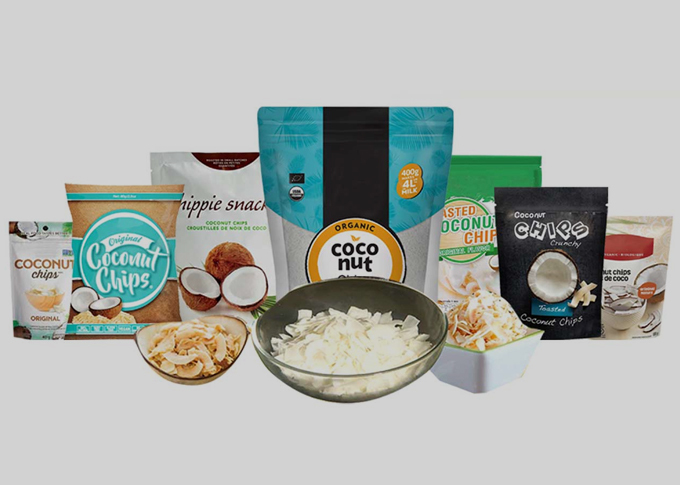
|
Composition of Coconut Chips |
||
|
Sl. No |
Parameters |
per 20 g |
|
1 |
Fat |
9.42g |
|
2 |
Lauric acid |
4.82g |
|
3 |
Calcium |
2.10mg |
|
4 |
Fiber |
1.93g |
|
5 |
Iron |
1.30mg |
|
6 |
Cholesterol |
0.00 |
Coconut oil is rather a unique cooking oil as it contains the short and the medium chain saturated fatty acids. It fi nds extensive use in the food industry due to its characteristics such as easy melting behaviour, resistance to oxidative rancidity, pleasing fl avour and good digestibility. Coconut oil has gained importance as a dietary fat because of its high content of lauric acid, the source of monolaurin in the body and 16W content of Omega 6. It can be used for manufacturing margarine and shortenings. Coconut oil is preferred as a fat in the preparation of fi lled milk, infant milk powder, ice-cream and confectionery and bakery products. Because of its stable character, coconut oil is the preferred fat for deep frying.
Studies undertaken by the Biochemistry Department, University of Kerala showed that coconut oil:
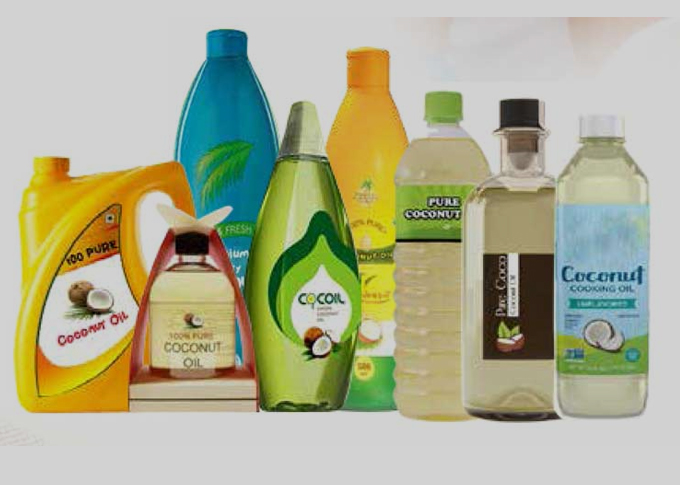
A large number of branded coconut oil in consumer packs are marketed in the country. Coconut oil is refi ned for industrial use. The refi ned coconut oil is water white in colour with no aroma. Since coconut oil has the lowest level of unsaturated fatty acids among all vegetable oils, the cost of hydrogenation is much less than all other oils.
|
Coconut oil - Product Specification |
|
|
(IS-542-1968) |
|
|
Moisture % wt., Max. |
0.25 |
|
Colour in 1/4 cell Lovibond Y+5R, not Deeper than |
4 |
|
Acid value, Max. |
2.0 |
|
Unsap. matter % by wt., Max. |
0.8 |
|
Polenske Value, Min. |
0.8 |
Two types of copra, namely the milling and the edible, are made in India. The milling copra is used to extract oil while the edible copra is consumed as a dry fruit. Edible copra is made in the forms of balls and cups. Copra contains the highest percentage of oil compared to other oil seeds. It contains 15-20 percent carbohydrates, 9 percent protein and 4.10 percent crude fi bre besides 65-68 percent fat. The carbohydrate fraction consists of a large percentage of cellulose and sucrose together with other sugars. Besides glucose and fructose the presence of galactose, raffi nose and pentoses is also reported.
